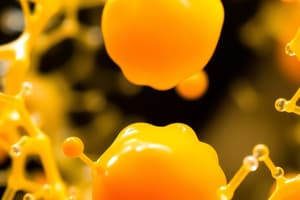Podcast
Questions and Answers
What is the primary purpose of increasing the roughness of metallic implants?
What is the primary purpose of increasing the roughness of metallic implants?
- To reduce osteointegration
- To increase the risk of implant rejection
- To improve osteointegration through better micromechanical retention (correct)
- To reduce the specific surface area of the implant
At what scale can roughness be modified to promote specific cellular responses?
At what scale can roughness be modified to promote specific cellular responses?
- Nanometric scale (correct)
- Macrometric scale
- Micrometric scale
- Mesometric scale
What is the importance of pores in implant design?
What is the importance of pores in implant design?
- To increase the specific surface area of the implant (correct)
- To increase protein adhesion
- To reduce protein adhesion
- To decrease the specific surface area of the implant
Which of the following is NOT a common method for modifying implant topography?
Which of the following is NOT a common method for modifying implant topography?
What is the correlation between roughness and osteoblast behavior?
What is the correlation between roughness and osteoblast behavior?
What is the primary mechanism by which roughness improves osteointegration?
What is the primary mechanism by which roughness improves osteointegration?
Which of the following is a strategy used in commercial implants?
Which of the following is a strategy used in commercial implants?
What is the effect of modifying topography on osteointegration?
What is the effect of modifying topography on osteointegration?
What is the nanometric scale used for in implant design?
What is the nanometric scale used for in implant design?
What is the goal of modifying the surface topography of implants?
What is the goal of modifying the surface topography of implants?
Flashcards are hidden until you start studying
Study Notes
Polymers in Medicine
- Polymetal Methacrylate (PMMA): a transparent, resistant, lightweight, and highly chemically inert polymer with good impact resistance.
- Applications: used as bone cement, fixation of hip, shoulder, knee, elbow prostheses, and in vertebroplasty and kyphoplasty.
- Requirements: fluid before implantation, solidifies (polymerizes) in situ.
Biomechanical Function of Acrylic Cement
- Load distribution: distributes loads evenly from the metal prosthesis to the surrounding tissue, preventing high stress concentrations.
- Fill and fit: allows for good filling of the bone cavity, promoting good primary fixation due to the proper fit and adjustment of the prosthesis-cement system.
Acrylic Cement Preparation
- Polymerization reaction: begins after mixing the two components, sets after 15 minutes, allowing for introduction into the bone cavity during this time.
Temporal Support
- Gradual transfer of functions: biodegradable implant must be gradually removed as the tissue heals, requiring a synchronized tissue regeneration.
Sutures
- Types: natural (plain catgut, chromic catgut, collagen) and synthetic (polyglycolic acid, polyglycolic acid coated with caprolactone, polygalactin) origin.
- Properties: tensile strength, uniform gauge, flexibility, and elasticity.
Orthopedic Fixation Systems
- PGA screws and plates: used for bone fractures with plates, good for probing, and can be removed after the process ends.
- Mechanical properties: can be enhanced by using reinforcing materials (composites) and ceramic faces.
Temporal Barriers
- Properties: good permeability, non-thrombogenic, easily modifiable, and minimal friction irritation.
- Applications: prevention of adhesion, prevention of particle migration, and controlled release of trapped molecules.
Improvement of Mechanical Properties
- Strategies: improving cross-linking, placing molecules with ceramic materials, and using different types of polymers.
Classification
- Synthetic polymers: acrylic hydrogels, PVA, PEG, PLA, synthesized in the laboratory.
- Natural polymers: collagen, gelatin, fibrin, hyaluronic acid, heparin, alginates, pectins, chitosan, obtained from natural sources.
Passivation vs Corrosion
- Passivation: prevents material surface from continuing to oxidize, acts as an insulator, and prevents material from releasing particles into the environment, ensuring biocompatibility.
Metallic Biomaterials
- Metals that meet requirements: iron, cobalt-chrome, and titanium alloys, used in orthopedics and dentistry.
Stainless Steel
- Properties: corrosion-resistant, magnetic, easy to machine, and good heat treatment.
- Applications: surgical materials, osteosynthesis plates, screws, and nails.
Physical Modifications
- Roughness: increasing roughness improves osteointegration through better micromechanical retention.
- Topography modification: strategy used in commercial implants to improve osteointegration.
- Methods: plasma spraying, grit blasting, acid etching, and electrochemical methods (anodization).
Studying That Suits You
Use AI to generate personalized quizzes and flashcards to suit your learning preferences.



